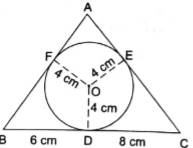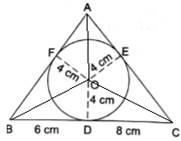A ΔABC is drawn to circumscribe a circle of radius 4 cm such that the segments BD and DC into which BC is divided by the point of contact D are of length 8 cm and 6 cm respectively. Find AB and AC.


Given: ΔABC that is drawn to circumscribe a circle with radius r = 4 cm and BD = 6 cm DC = 8 cm
To Find: AB and AC
Now,
As we know tangents drawn from an external point to a circle are equal.
Then,
FB = BD = 6 cm [Tangents from same external point B]
DC = EC = 8 cm [Tangents from same external point C]
AF = EA = x (let) [Tangents from same external point A]
Using the above data we get
AB = AF + FB = x + 6 cm
AC = AE + EC = x + 8 cm
BC = BD + DC = 6 + 8 = 14 cm
Now we have heron's formula for area of triangles if its three sides a, b and c are given
ar = √(s(s – a)(s – b)(s – c))
Where,
![]()
So for ΔABC
a = AB = x + 6
b = AC = x + 8
c = BC = 14 cm
![]()
And
ar(ΔABC) = √((x + 14)(x + 14 – (x + 6))(x + 14 – (x + 8))(x + 14 – 14))
= √((x + 14)(8)(6)(x)) [1]
ar(ABC) = ar(AOB) + ar(BOC) + ar(AOC)
at, tangent at a point on the circle is perpendicular to the radius through point of contact,
So, we have
OF ⏊ AB, OE ⏊ AC and OD ⏊ BC
Therefore, AOB, BOC and AOC are right – angled triangles.
And area of right angled triangle =1/2 × Base × Height
Using the formula,
![]()
Using [1] we have,
![]()
Squaring both side
⇒ 48x(x + 14) = (2x + 6 + 28 + 2x + 16)2
⇒ 48x2 + 672x = (56 + 4x)2
⇒ 48x2 + 672x = (4(14 + x))2
⇒ 48x2 + 672x = 16(196 + x2 + 28x)
⇒ 3x2 + 42x = 196 + x2 + 28x
⇒ 2x2 + 14x – 196 = 0
⇒ x2 + 7x – 98= 0
⇒ x2 + 14x – 7x – 98 = 0
⇒ x(x + 14) – 7(x + 14) = 0
⇒ (x – 7)(x + 14) = 0
⇒ x = 7 or x = – 14 cm
Negative value of x is not possible, as length can't be negative
Therefore,
x = 7 cm
⇒ AB = x + 6 = 7 + 6 = 13 cm
⇒ AC = x + 8 = 7 + 8 = 15 cm